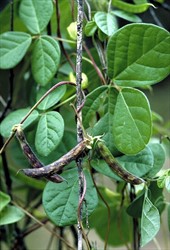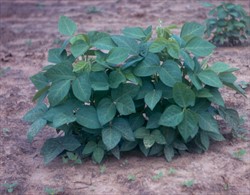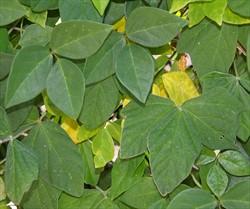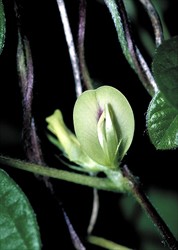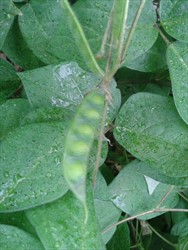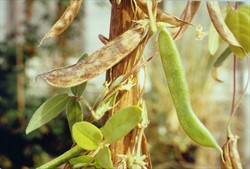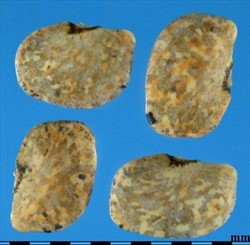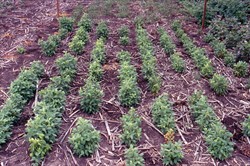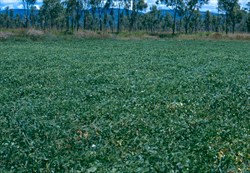Macrotyloma uniflorum
Tropical Forages
Macrotyloma uniflorum (Lam.) Verdc.
Subordinate taxa:
Macrotyloma uniflorum (Lam.) Verdc. var. benadirianum (Chiov.) Verdc.
Macrotyloma uniflorum (Lam.) Verdc. var. stenocarpum (Brenan) Verdc.
Macrotyloma uniflorum (Lam.) Verdc. var. uniflorum
Macrotyloma uniflorum (Lam.) Verdc. var. verrucosum Verdc.
var. benadirianum: Basionym: Dolichos benadirianus Chiov.
var. uniflorum: Basionym: Dolichos uniflorus Lam.; Dolichos biflorus auct.
var. stenocarpum: Basionym: Dolichos uniflorus Lam. var. stenocarpus Brenan
Family: Fabaceae (alt. Leguminosae) subfamily: Faboideae tribe: Phaseoleae subtribe: Phaseolinae.
Twining, erect, sub-erect or trailing, annual or perennial herb 30–60 cm tall in pure stands, or 60–90 cm with support framework. Stems cylindrical, slightly hairy to tomentose with whitish hairs. Leaves trifoliolate; stipules lanceolate (4‒) 8‒10 mm long; petiole 0.8‒7.0 cm long; leaflets ovate, ovate-rhomboid, obovate, or elliptic, oblique, rounded at the base, apex acute or slightly acuminate, terminal leaflet symmetrical, laterals asymmetrical, (1.8–) 3.5–5 (–8) cm long, (0.7‒) 2‒6 (‒7.8) cm broad, glabrous or puberulent (rarely velutinous) on both surfaces, fimbriolate, paler beneath. Inflorescence axillary, with flowers solitary, in pairs or in 3 (‒5)-flowered fascicles or compact racemes with peduncle and rachis 0‒1.5 cm; calyx tube ca. 2 mm; lobes triangular-lanceolate, 3‒8 mm, tomentose, upper 2 united; standard near white to pale greenish yellow, oblong, obovate-oblong, (6‒) 9‒10.5 (‒12) mm long, 4‒8 mm broad, with light purple spot in middle; wings light yellowish green, about as long as the keel, 8–9.5 mm long. Pod linear-oblong, straight or slightly curved, pubescent or glabrous, 2.5‒6 cm long, about 4‒8 mm broad, 5‒10 seeded, curved beak 5‒10 mm long. Seed ovoid, oblong or orbicular-reniform, 3‒8 mm long, 4‒5 mm broad, pale fawn, light red, deep reddish brown, or black sometimes with faint mottles or with small, scattered black spots,(or both); hilum central. 33,000‒75,000 seeds per kg.
var. uniflorum: pods 6‒8 mm wide.
var. stenocarpum: pods 4‒5.5 mm wide; leaflets pubescent; sutures of pods not warted.
var. verrucosum: pods 4‒5.5 mm wide; leaflets pubescent; sutures of pods obscurely to markedly warted.
var. benadirianum: pods 4‒5.5 mm wide; leaflets densely velvety; sutures of pods slightly warted.
Asia: 硬皮豆 ying pi dou, chang geng pi dou (Mandarin) (China); kekara; kacang karas, rarawea (Indonesia); pé-bi-zât (Myanmar)
English: horse gram, horse grain, kulthi bean, madras bean, madras gram, poor man’s pulse; biflorus (Australia)
Europe: paardekeker (Flemish); dolic biflore, grain de cheval (Frenck); Pferdebohne, Pferdekorn (German); dolico cavallino (Italian)
Indian subcontinent: gahat, kulath (Hindi); ಹುರಳಿಸಾರು huraLi saaru, ಹುರಳಿ huraLi (Kannada); कुळीथ kulith (Marathi); മുതിര muthira (Malayalam); kulattha, kulathika, sweta beeja (Sanskrit); கொள்ளு kollu (Tamil); ఉలవలు ulavalu (Telugu); kulthi (Urdu)
Latin America: culita, faveira, favalinha, feijoeiro de lagartixa (Brazil); frijol verde (Spanish)
var. benadirianum
Native:
Africa: Kenya; Somalia
Wild plant in sand dunes
var. stenocarpum
Native:
Africa: Angola; Botswana; Democratic Republic of the Congo; Ethiopia; Kenya; Mozambique; South Africa (Transvaal); Tanzania; Zimbabwe
Asia: India (wild plant in Acacia bushland and thickets)
var. uniflorum
Native:
Africa: Namibia
Asia: India; Nepal; Pakistan (n.)
Cultivated:
Widely cultivated in the tropics as a pulse, ground cover and forage crop.
var. verrucosum
Native:
Africa: Kenya; Mozambique; Tanzania (wild plant in grassland)
Forage
Grown as a pulse, for deferred grazing or as a fodder crop for dry season feed for livestock. Has value as a pioneer legume or sometimes a regenerating annual in permanent pasture.
Environment
Used as green manure.
Other
Cultivated for human consumption in India; also in Sri Lanka, Malaysia and West Indies, mostly as an intercrop with annual grains (e.g. sorghum) or in orchards. Different part of the plant are used for the treatment of a range of conditions in folk medicine.
Soil requirements
Adapted to a wide range of well-drained soils from sands and gravels to clay loams and heavy clays. Prefers near neutral soils, but will grow down to pH 5 or 5.5, and up to about 8. Tolerant of low to moderate salinity (4–10 dS/m).
Moisture
African collections originate from areas with annual rainfall from 450 to 750 mm, and Indian collections, 600‒2,200 mm, and the overall majority from 550 to 1,000 mm, usually with a high summer dominance. Cultivated in areas with rainfall as low as 300 mm/yr. Leaf disease can be a problem in higher rainfall areas, overcome by growing crops on residual soil moisture in the dry season. Very drought tolerant, but does not tolerate flooding or waterlogging.
Temperature
Native to or cultivated from the equator to 28º latitude, and from near sea level to 1,800 m asl, in areas with an annual average temperature range of about 18–27 ºC. Best growth is produced during hot moist weather, with temperatures between about 25 ºC and 35 ºC, the growth rate declining markedly below 20 ºC. It is completely intolerant of frost, but usually seeds before the frosts and regenerates in the summer from seed.
Light
Low shade tolerance.
Reproductive development
Short day and day neutral in flowering response. May take as little as 40 days, but usually 120–180 days to reach maturity.
Defoliation
If sown as a fast-developing pioneer, it provides useful early feed in a forage system. Green fodder can be cut as soon as 6 weeks after sowing. However, unless allowed to seed, there is no chance of regeneration in the following year. Grows vigorously in summer, seeds early and then drops its leaves in autumn to early winter. It is best managed as a dry season feed reserve, with the high quality seed-in-pod remaining on the bush, and fallen leaf licked from the ground.
Fire
Easily killed by fire.
Guidelines for establishment and management of sown forages.
Establishment
Hard seed levels are usually of the order of 5–10% so scarification is not necessary. Similarly, inoculation is usually not essential, since, like M. axillare, M. uniflorum is fairly promiscuous in its rhizobial requirement, mostly nodulating satisfactorily with existing strains of bacteria in the soil. However, most effective strains of Bradyrhizobium are Group J type, (CB 1024, commercial in Australia) and the Group M type (CB 756, recommended for use on Macroptilium and many other tropical legumes in Australia). The latter produces black nodules, which are still effective. Normally drilled or broadcast into a well-prepared seedbed, but can establish with little ground disturbance. Sometimes sown with maize (Zea mays), so they mature together, the legume improving the quality of the maize residue. Seed is sown in spring to early summer, 1–1.5 cm deep and lightly covered. Suggested sowing rates range from 1–3 kg/ha in mixed pasture, to 5–10, and up to 45 kg/ha in pure stands.
Fertilizer
Although growing fairly well at low fertility, even on old cultivation land, it responds to applications of 10–20 kg/ha P on poorer soils.
Compatibility (with other species)
The twining habit enables M. uniflorum to climb taller grasses and crop plants, and to smother weeds.
Companion species
Grasses: Heteropogon contortus, Megathyrsus maximus.
Legumes: Macroptilium atropurpureum, Stylosanthes scabra.
Pests and diseases
Although affected in various places by a large range of pests and diseases, these rarely cause major problems. In more humid environments, powdery mildew (Sphaerotheca fuliginea) and a leaf spot (Cercospora dolichi) may cause damage as plants approach maturity. In high rainfall conditions, another leaf spot (Ascochyta sp.) and web blight (Thanatephorus cucumeris = Rhizoctonia solani) can cause severe damage. Other diseases include anthracnose (Colletotrichum lindermuthianum), rust (Uromyces appendiculatus), root rot (Pellicularia filamentosa) and dry root rot (Macrophomina phaseolina). Seed yields can be reduced by pod rot during late season rains, pod borers, and rodents. Bean fly (Ophiomyia (Agromyza, Melanagromyza) phaseoli Diptera: Agromyzidae) sometimes attacks young seedlings
Subject to attack by a wide range of viruses: bean mild mosaic carmovirus, bean yellow mosaic potyvirus, blackgram mottle carmovirus, chickpea bushy dwarf potyvirus, cowpea mottle carmovirus, desmodium yellow mottle tymovirus, glycine mosaic comovirus, glycine mottle carmovirus, guar symptomless potyvirus, horsegram yellow mosaic bigeminivirus, kennedya yellow mosaic tymovirus, mung bean yellow mosaic bigeminivirus, passionfruit woodiness potyvirus, soybean mild mosaic virus, soybean mosaic potyvirus, subterranean clover stunt nanavirus, sunflower ringspot ilarvirus, tobacco streak ilarvirus, watermelon mosaic 2 potyvirus. Yellow mosaic virus is one of the major constraints for its cultivation in peninsular India.
Ability to spread
Low levels of hard seed reduce the amount of seed passing undigested through the grazing animal, and hence the potential for spread in this way. Need at least 15% hard seed for this to be an effective spread mechanism.
Weed potential
Not sufficiently vigorous to pose a weed threat.
Nutritive value
Crude protein levels of the mature whole plant are about 11–18%, and of the seed, 22–25%.
Palatability/acceptability
As with its perennial relative, Macrotyloma axillare, it is often not relished by cattle on first introduction, but then well eaten following a period of adjustment.
Toxicity
Possibility of antinutritional/toxic factors in untreated seed, broken down by heat. Usually fed to horses and cattle after boiling.
Feedipedia link
April 2020: Page under construction
Dry matter
Under good growing conditions can produce >6 t/ha DM, but under semi-arid conditions, <1 t/ha.
Animal production
Steers can gain 0.25–0.64 kg/head/day with dry season grazing, largely as a result of improved crude protein intake.
Diploid, 2n = 20, 22, (24). Flowers are self-fertile and cleistogamous, although evidence of some cross-pollination by insects. Can be crossed with M. axillare.
Seed yields vary markedly with growing conditions. Under ideal conditions, seed yields of >2 t/ha have been achieved, while under semi-arid conditions, yields may be as low as 0.2–0.4 t/ha, the average being about 1 t/ha. In the southern hemisphere dry tropics, ‘Leichhardt’, if planted in January, makes vigorous early growth, commences flowering in mid March, and matures by late May. The pods are indehiscent and retain the seed.
No information available.
- Rapid summer growth.
- High seed yields.
- Drought tolerance.
- Poor persistence.
- Late season defoliation.
- Low palatability until animals become accustomed.
- Some toxicity in untreated seeds.
Blumenthal, M.J. and Staples, I.B. (1993) Origin, evaluation and use of Macrotyloma as forage -a review. Tropical Grasslands 27:16–29. bit.ly/3awFf8j
Blumenthal, M.J., O'Rourke, P.K., Hilder, T.B. and Williams, R.J. (1989) Classification of the Australian collection of the legume Macrotyloma. Australian Journal of Agricultural Research 40(3):591–604. doi.org/10.1071/AR9890591
Purseglove, J.W. (1974) Tropical Crops: Dicotyledons. Longman Group Ltd., London, UK. p. 263–264.
Smartt, J. (1990) Horse gram. Grain Legumes. Cambridge University Press, Cambridge, UK. p. 298–299. doi.org/10.1017/CBO9780511525483
van Rensburg, H.J. (1967) Pasture Legumes and Grasses in Zambia. Govt. Printer, Lusaka, Zambia.
Verdcourt, B. (1970) Studies in the Leguminosae-Papilionoideae for the 'Flora of Tropical East Africa': III. Kew Bulletin 24: 379–447. doi.org/10.2307/4102845
Verdcourt, B. (1980) The classification of Dolichos L. emend. Verdc., Lablab Adans., Phaseolus L., Vigna Savi and their allies. In: Summerfield, R.J. and Bunting, A.H. (eds) Advances in Legume Science. Kew Royal Botanic Gardens, Kew, UK. p. 45–48.
Verdcourt, B. (1982) A revision of Macrotyloma (Leguminosae). Hooker's Icones Plantarum 38(4):1–138.
‘Leichhardt’ (CPI 26260) var. stenocarpum Released in Queensland, Australia (1966). Origin unknown. Vigorous, twining annual herb with cylindrical tomentose stems. Initially considered a potential dry season supplement for low quality native pasture. Superseded by the advent of various Stylosanthes spp., particularly S. scabra. Seed is no longer commercially available.
Numerous varieties have been released as pulse for human and livestock consumption.
None reported for forage use.
